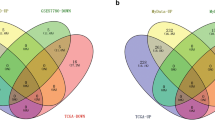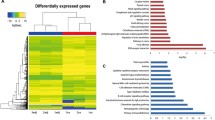Abstract
Purpose
Identification of stage-specific prognostic/predictive biomarkers in papillary thyroid carcinoma (PTC) could lead to its more efficient clinical management. The main objective of this study was to characterize the stage-specific deregulation in genes and miRNA expression in PTC to identify potential prognostic biomarkers.
Methods
495 RNASeq and 499 miRNASeq PTC samples (stage I–IV) as well as, respectively, 56 and 57 normal samples were retrieved from The Cancer Genome Atlas (TCGA). Differential expression analysis was performed using DESeq 2 to identify deregulation of genes and miRNAs between sequential stages. To identify the minority of patients who progress to higher stages, we performed clustering analysis on stage I RNASeq data. An independent PTC RNASeq data set (BioProject accession PRJEB11591) was also used for the validation of the results.
Results
LTF and PLA2R1 were identified as two promising biomarkers down-regulated in a subgroup of stage I (both in TCGA and in the validation data set) and in the majority of stage IV of PTC (in TCGA data set). hsa-miR-205, hsa-miR-509-2, hsa-miR-514-1 and hsa-miR-514-2 were also detected as up-regulated miRNAs in both PTC patients with stage I and stage III. Hierarchical clustering of stage I samples showed substantial heterogeneity in the expression pattern of PTC indicating the necessity of categorizing stage I patients based on the expressional alterations of specific biomarkers.
Conclusion
Stage I PTC patients showed large amount of expressional heterogeneity. Therefore, risk stratification based on the expressional alterations of candidate biomarkers could be an important step toward personalized management of these patients.






Similar content being viewed by others
Availability of data and material
Data are available at (http://portal.gdc.cancer.gov/).
References
Bray F et al (2018) Global cancer statistics 2018: GLOBOCAN estimates of incidence and mortality worldwide for 36 cancers in 185 countries. CA A Cancer J Clin 68(6):394–424
Katoh H et al (2015) Classification and general considerations of thyroid cancer. Ann Clin Pathol 3(1):1045
Agrawal N et al (2014) Integrated genomic characterization of papillary thyroid carcinoma. Cell 159(3):676–690
Haraldsdottir S, Shah MH (2014) New era for treatment in differentiated thyroid cancer. The Lancet 384(9940):286–288
Liu R et al (2018) Regulation of mutant TERT by BRAF V600E/MAP kinase pathway through FOS/GABP in human cancer. Nat Commun 9(1):579
Teng H et al (2018) Transcriptomic signature associated with carcinogenesis and aggressiveness of papillary thyroid carcinoma. Theranostics 8(16):4345
Love M, Anders S, Huber W (2014) Differential analysis of count data–the DESeq2 package. Genome Biol 15(550):10.1186
Chen EY et al (2013) Enrichr: interactive and collaborative HTML5 gene list enrichment analysis tool. BMC Bioinf 14(1):128
Kanehisa M et al (2016) KEGG: new perspectives on genomes, pathways, diseases and drugs. Nucleic Acids Res 45(D1):D353–D361
UniProt: the universal protein knowledgebase. (2016) Nucleic Acids Res 45(D1): D158–D169
Seliger C et al (2013) Lactate-modulated induction of THBS-1 activates transforming growth factor (TGF)-beta2 and migration of glioma cells in vitro. PLoS ONE 8(11):e78935
Amoli MM et al (2010) HLA-DR association in papillary thyroid carcinoma. Dis Markers 28(1):49–53
Jo YS et al (2008) Significance of the expression of major histocompatibility complex class II antigen, HLA-DR and-DQ, with recurrence of papillary thyroid cancer. Int J Cancer 122(4):785–790
Soini Y, Pääkkö P, Lehto V (1998) Histopathological evaluation of apoptosis in cancer. Am J Pathol 153(4):1041–1053
Gottfried Y et al (2004) Expression of the pro-apoptotic protein ARTS in astrocytic tumors: Correlation with malignancy grade and survival rate. Cancer Interdiscip Int J Am Cancer Soc 101(11):2614–2621
Poulios E et al (2018) Identification of a novel, diagnostic microRNA signature in papillary thyroid cancer. J Med Surg Pathol 162–167
Yu S et al (2012) Circulating microRNA profiles as potential biomarkers for diagnosis of papillary thyroid carcinoma. J Clin Endocrinol Metabol 97(6):2084–2092
Blanco CG, Matute EM, de Leiva Hidalgo A (2012) Molecular biomarkers involved in the tumor dedifferentiation process of thyroid carcinoma of epithelial origin: perspectives. Endocrinol Nutr 59(7):452–458
Acquaviva G et al (2018) Molecular pathology of thyroid tumours of follicular cells: a review of genetic alterations and their clinicopathological relevance. Histopathology 72(1):6–31
Liyanarachchi S et al (2016) Genome-wide expression screening discloses long noncoding RNAs involved in thyroid carcinogenesis. J Clin Endocrinol Metabol 101(11):4005–4013
Brennan K et al (2016) Development of prognostic signatures for intermediate-risk papillary thyroid cancer. BMC Cancer 16(1):736
Menschikowski M et al (2015) Epigenetic control of phospholipase A 2 receptor expression in mammary cancer cells. BMC Cancer 15(1):971
Salazar M et al (2015) Loss of Tribbles pseudokinase-3 promotes Akt-driven tumorigenesis via FOXO inactivation. Cell Death Differ 22(1):131
Lu C et al (2011) Genomic profiling of genes contributing to metastasis in a mouse model of thyroid follicular carcinoma. Am J Cancer Res 1(1):1
Rodriguez MCP et al (2012) Methods for diagnosing follicular thyroid cancer. Google Patents
Song J, Yang Z (2018) Case report: whole exome sequencing of circulating cell-free tumor DNA in a follicular thyroid carcinoma patient with lung and bone metastases. J Circ Biomark 7:1849454418763725
Cerutti JM et al (2007) Molecular profiling of matched samples identifies biomarkers of papillary thyroid carcinoma lymph node metastasis. Can Res 67(16):7885–7892
Qian Z et al (2014) High expression of TNFSF13 in tumor cells and fibroblasts is associated with poor prognosis in non-small cell lung cancer. Am J Clin Pathol 141(2):226–233
Huang Y et al (2001) Gene expression in papillary thyroid carcinoma reveals highly consistent profiles. Proc Natl Acad Sci 98(26):15044–15049
Niedźwiecki S et al (2008) Serum levels of interleukin-1 receptor antagonist (IL-1ra) in thyroid cancer patients. Langenbeck’s Archiv Surg 393(3):275–280
Joung KH, Shong M (2012) Epigenetic regulation of RUNX3 in thyroid carcinoma. Korean J Int Med 27(4):391
dos Reis M et al (2016) Epigenetic alterations in well-differentiated thyroid cancer. J Clin Epigenet 1:1
Moarii M et al (2015) Changes in correlation between promoter methylation and gene expression in cancer. BMC Genom 16(1):873
Saiselet M et al (2016) miRNA expression and function in thyroid carcinomas: a comparative and critical analysis and a model for other cancers. Oncotarget 7(32):52475
Mancikova V et al (2015) MicroRNA deep-sequencing reveals master regulators of follicular and papillary thyroid tumors. Mod Pathol 28(6):748
Zhang P et al (2018) Association of miR-1247-5p expression with clinicopathological parameters and prognosis in breast cancer. Int J Exp Pathol 99(4):199–205
Fang T et al (2018) Tumor-derived exosomal miR-1247-3p induces cancer-associated fibroblast activation to foster lung metastasis of liver cancer. Nat Commun 9(1):191
He J, Wang H (2019) HspA1B is a prognostic biomarker and correlated with immune infiltrates in different subtypes of breast cancers. bioRxiv 1–31. https://doi.org/10.1101/725861
Peng JX, Liang SY, Li L (2019) sFRP1 exerts effects on gastric cancer cells through GSK3β/Rac1-mediated restraint of TGFβ/Smad3 signaling. Oncol Rep 41(1):224–234
Fadda G (2012) Application of liquid-based cytology to fine-needle aspiration biopsies of the thyroid gland. Front Endocrinol 3:57
Del Pino M et al (2015) mRNA biomarker detection in liquid-based cytology: a new approach in the prevention of cervical cancer. Mod Pathol 28(2):312
Acknowledgements
The authors gratefully acknowledge the supports provided by Iran University of Medical Sciences (Grant number 33444).
Funding
Financial support was provided by Iran University of Medical Sciences (Grant number 33444).
Author information
Authors and Affiliations
Contributions
M. K designed and supervised the project. N. H performed the data analyses and wrote the manuscript. K. B, M. K and M. H commented on the manuscript. T. M reviewed the paper.
Corresponding author
Ethics declarations
Conflict of interest
The authors declare that they have no conflict of interest.
Ethics approval and consent to participate
Ethical approval for this study was obtained from The Committee for Ethics in Research Involving Human Subjects, Iran University of Medical Sciences (Ethical code—IR.IUMS.REC.1397.203).
Additional information
Publisher's Note
Springer Nature remains neutral with regard to jurisdictional claims in published maps and institutional affiliations.
Electronic supplementary material
Below is the link to the electronic supplementary material.
Rights and permissions
About this article
Cite this article
Hosseinkhan, N., Honardoost, M., Blighe, K. et al. Comprehensive transcriptomic analysis of papillary thyroid cancer: potential biomarkers associated with tumor progression. J Endocrinol Invest 43, 911–923 (2020). https://doi.org/10.1007/s40618-019-01175-7
Received:
Accepted:
Published:
Issue Date:
DOI: https://doi.org/10.1007/s40618-019-01175-7




